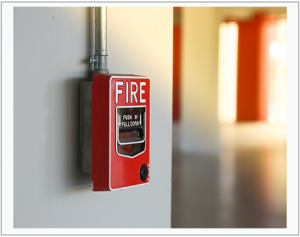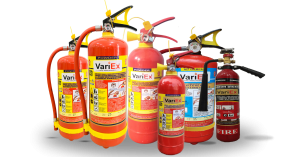![]()
Fire Immuniser
+91-7829629111
Email: info@variex.in
Varistor Technologies Pvt. Ltd.
Block-1, First Floor, Ardente Office One, Hoodi Circle, ITPL Main Road, Bengaluru, Karnataka 560048, IN
Fire Fighting System Installation
The installation of fire fighting systems stands as a crucial measure to safeguard lives and property against the devastating effects of fire. Whether in residential, commercial, or industrial settings, a well-designed and properly installed fire fighting system is indispensable. This informative content will delve into the key aspects of fire fighting system installation, highlighting its importance, components, and installation process.
Importance of Fire Fighting System Installation:
Life Protection: The primary objective of any fire fighting system is to protect human life. In the event of a fire outbreak, these systems provide early detection and suppression, allowing occupants to evacuate safely.
Property Protection: Fire can cause significant damage to property, leading to substantial financial losses. A well-installed fire fighting system can mitigate the extent of damage by containing or extinguishing the fire before it spreads extensively.
Compliance with Regulations: Regulatory bodies and building codes often mandate the installation of fire fighting systems in various types of structures. Compliance ensures legal adherence and enhances overall safety standards.
Insurance Requirements: Insurance providers may require the installation of fire fighting systems as a prerequisite for coverage. Implementing such systems not only reduces the risk of fire-related losses but also demonstrates proactive risk management to insurers.
Components of Fire Fighting Systems:
Fire Detection Systems: These systems utilize various technologies such as smoke detectors, heat detectors, and flame detectors to detect the presence of fire. Early detection is critical for initiating timely response actions.
Alarm Systems: Upon detection of fire, alarm systems activate audible and visual signals to alert occupants of the building. These alarms prompt swift evacuation and notify emergency responders.
Suppression Systems: Suppression systems are designed to control or extinguish fires. They include:
- Water-Based Systems: Such as sprinkler systems, which release water upon detection of fire to suppress flames and cool the affected area.
- Gaseous Systems: Utilize agents like carbon dioxide or clean agents to displace oxygen or inhibit the chemical reactions essential for fire.
- Foam Systems: Deploy foam to smother fires, particularly those involving flammable liquids.
Emergency Lighting: In the event of a fire, power outages are common. Emergency lighting systems ensure visibility during evacuations and aid emergency responders in navigating the premises.
Installation Process:
Assessment and Design: The installation process begins with a comprehensive assessment of the building's layout, occupancy, and fire risks. Based on this assessment, engineers design a customized fire fighting system tailored to the specific requirements and hazards of the structure.
Equipment Selection: Following the design phase, appropriate fire detection, alarm, suppression, and emergency lighting equipment are selected. Factors such as reliability, compatibility, and compliance with regulations influence equipment choices.
Installation and Integration: Qualified technicians install the selected components according to the approved design and manufacturer's specifications. Integration with building infrastructure and electrical systems ensures seamless operation and reliable performance.
Testing and Commissioning: Upon installation, rigorous testing and commissioning procedures are conducted to verify the functionality and effectiveness of the fire fighting system. This includes simulation tests, sensor calibration, and coordination with emergency response protocols.
Training and Maintenance: Occupants and building staff receive training on the operation and maintenance of the fire fighting system. Regular maintenance schedules are established to ensure the system remains in optimal condition, with periodic inspections and testing conducted by certified professionals.
Risk Assessment and Fire Safety Planning
Before installing fire fighting systems, thorough risk assessment is vital. This includes identifying hazards, evaluating occupancy, analyzing escape routes, and assessing building integrity. Engineers use this assessment to customize systems for comprehensive protection.
Types of Fire Fighting Systems:
Automatic Sprinkler Systems: These are the most common type of fire suppression systems, consisting of a network of pipes with sprinkler heads strategically placed throughout the building. Upon detection of heat or flames, individual sprinkler heads activate to release water, effectively suppressing the fire.
Fire Alarm Systems: Fire alarms are crucial for early detection and evacuations, integrating smoke detectors, heat sensors, manual pull stations, and alarms to warn occupants promptly during fires.
 Fire Extinguishers: Though not comprehensive alone, portable fire extinguishers are vital for fire safety, enabling occupants to intervene early and prevent small fires from spreading.
Fire Extinguishers: Though not comprehensive alone, portable fire extinguishers are vital for fire safety, enabling occupants to intervene early and prevent small fires from spreading.Special Hazard Suppression Systems: Some environments like server rooms, labs, or industrial facilities may need specialized suppression systems using agents like clean agents, CO2, or foam to extinguish fires without harming sensitive equipment.
Integration with Building Systems: Integrated fire fighting systems optimize performance and coordination during emergencies by linking with HVAC, access control, and automation systems. This enables automated responses like HVAC shutdown, door unlocking, and emergency lighting activation during fires.
Compliance and Regulations: Fire fighting system installation must adhere to national and local building codes, regulations, and standards, which dictate system types, installation methods, maintenance schedules, and testing procedures to ensure safety compliance.
Emerging Technologies: Advancements in technology continue to drive innovation in fire fighting systems. Wireless communication, smart sensors, and Internet of Things (IoT) devices enable remote monitoring, predictive maintenance, and real-time data analytics, enhancing the effectiveness and efficiency of fire safety measures.
Emergency Response Planning: In addition to the installation of fire fighting systems, comprehensive emergency response planning is essential. This includes establishing evacuation procedures, conducting fire drills, training personnel in fire safety protocols, and coordinating with local emergency services to ensure a swift and coordinated response to fire emergencies.
In conclusion, the installation of fire fighting systems is an essential investment in safety and risk mitigation for any building or facility. These systems, with advanced technology, regulatory compliance, and professional installation, offer a crucial defense against fires, saving lives and protecting property.
Frequently Asked Questions
A fire fighting system is a combination of equipment and measures designed to detect, control, and extinguish fires. It is essential to install fire fighting systems to protect lives, property, and assets from the devastating effects of fires by providing early detection, suppression, and evacuation alerts.
Fire fighting systems typically include fire detection systems (smoke detectors, heat sensors), alarm systems (audible and visual alerts), suppression systems (sprinklers, gaseous agents), emergency lighting, and fire extinguishers.
The type of fire fighting system depends on factors such as building occupancy, fire hazards, regulatory requirements, and budget constraints. A thorough risk assessment conducted by qualified professionals can help determine the most appropriate system for your specific needs.
Yes, national and local building codes, regulations, and standards mandate the installation of fire fighting systems in various types of buildings and structures. Compliance with these regulations ensures adherence to safety standards and legal requirements.
The installation process typically involves assessment and design, equipment selection, installation and integration, testing and commissioning, and training and maintenance. Qualified technicians follow approved designs and manufacturer specifications to ensure proper installation and functionality.
Final Say
We at VariEx.in or Variexonline.com have mastered the art of designing, installing, inspecting, and fixing automatic sprinkler systems with the help of our in-house team, which is capable of delivering the fire sprinkler services you need, whether large or small and at affordable cost.
To schedule a fire sprinkler installation, or you think our services could benefit your commercial property, contact us online or give us a call at, 7829629111


